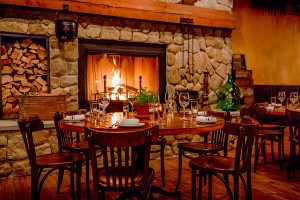First Course: Elephant Walk's “Market Day” Class
 The best — and perhaps most obvious — indicator of a good teacher is the success of the students once they actually leave the classroom.
The best — and perhaps most obvious — indicator of a good teacher is the success of the students once they actually leave the classroom.
That’s what I find myself thinking as I stir homemade lemongrass paste into a sizzling pan of sliced pork, baby eggplant, and onion the day after my lesson in Cambodian cuisine with Elephant Walk chef and co-owner Longteine “Nyep” de Monteiro. I’m a huge fan of Southeast Asian fare, but making it at home has always been a mystery to me. Which is precisely why the Elephant Walk’s annual “Market Day” class seemed like the perfect place to begin my journey — in it students learn not only how to prepare Cambodian food, but also how to buy Cambodian ingredients.
I arrive early Saturday morning at the Elephant Walk’s Brookline location and enjoy a cup of coffee with my new acquaintances. We pack into a van and head north to Revere Beach. First stop: Battambang Market, a small Southeast Asian grocery packed with exotic vegetables, imported frozen fish, and enticing condiments. De Monteiro first takes us on a tour of the produce aisle, where she deciphers all manner of curious items, including mangosteen, fuzzy squash, bitter melon, an herb that apparently has the flavor of sulfur. Then we have a lesson in popular Cambodian freshwater fish — like the snakehead, which Battamabang carries frozen — and good fish sauce (I pick up a bottle of Three Crabs Brand). A couple of fried taro treats later, we load back onto the bus, this time weighed down with plenty of shopping bags from our adventure.
A beautifully set table awaits us at the Elephant Walk, but the kitchen is where everyone really wants to be. Although the dishes de Monteiro has chosen for the day — ginger catfish; Cambodian ratatouille; green mango salad; and loc lac, or marinated beef with lime sauce — are complex in flavor, they’re actually fairly quick and easy to prepare. We break into groups and begin slicing, shredding, and sauteing the meat and vegetables. The sweet-spicy scent that results from two cups of fresh julienned ginger hitting the pan for the catfish is a feast for the nose. The refreshing fragrance of the lemongrass paste as it coats the eggplant, buttercup squash, and green papaya in the ratatouille makes us even hungrier.
And then we learn the secret to what makes Southeast Asian food so delicious: sugar. De Monteiro pours some into the beef, the ginger fish, and the ratatouille, and it, along with fish sauce, lends all the dishes a distinctive tanginess that no one can resist when we sit down to eat our lunch. We pack up the (sparse) leftovers and say our goodbyes, leaving the restaurant weighed down with our shopping treasures and copies of de Monteiro’s cookbook (which also contains some of her own fascinating history).
Flash-forward one day, and I’m in my own tiny kitchen, using my mediocre blender to whip lemongrass, fresh turmeric, galangal, and chilies into the same beautiful paste we created at the Elephant Walk. It comes out perfectly, as does the sliced pork loin I serve with it. As for the pad thai I make as a side? Let’s just say there’s a Thai cooking class somewhere in my near future.
The Elephant Walk offers various classes in French and Cambodian cuisine throughout the year. For more information, go to elephantwalk.com.


